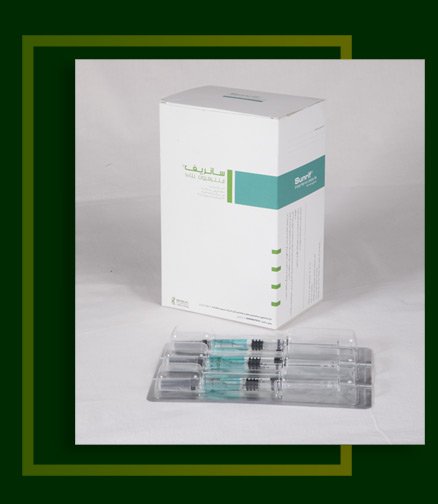Biosimilar (Sunrif)
What is Sunrif ?
There is no drug for full treatment and recuperation of MS disease; however, treatment and care can decrease MS attacks and its progress and returning function after an attack. Our body has molecules called Interferons (IFNs) that strengthen cells against viral attacks and repel them. At least three different types of human IFNs have been identified which are divided into alpha, beta and gamma IFNs, based on their anti-viral and anti-growth effects and activation of natural killer cell. Today, recombinant IFN beta is producing in different mammalian and bacterial hosts, which are known as interferon beta 1A and 1B, respectively.
“Sunriff®” is the trade name for interferon beta 1A (solution form). In Iran, this drug has been produced by Biosun as a biosimilar drug.
Sunrif is the brand name for interferon beta-1A (soluble form).
After transferring the technology of the interferon beta-1a product line from Argentina to our country, it is available free of charge to the patients. Sunrif is a recombinant human protein produced by genetic engineering. It reduces the number and severity of the disease's attacks to the patient.

What are the contraindications for Sunrif?
Observation of increased allergy to Sunrif or any component in the drug combination (with symptoms such as dyspnea, lung drainage, swelling of the face, lips, tongue or other parts of the body, itching and rash or hives), pregnancy, severe liver disease, severe depression (feelings of sadness or incompetence or having suicidal thoughts) and epileptic seizures that have not been treated completely.
Is it harmful to take Sunrif during pregnancy and lactation?
Sunrif is contraindicated during pregnancy. Effective contraceptives should be used if a patient suffering from MS takes sunrif at the age of fertility. Also, if a person has a plan for future pregnancy, he/she should consult with his/her physician beforehand. It is not yet clear whether interferon is entered into the breast milk during breastfeeding. Therefore, in case of breastfeeding, the patient should consult with his physician. The physician makes a decision, taking into account the benefits and disadvantages of continued drug use.
Is it harmful to take Sunrif during pregnancy and lactation?
Usually, flu-like symptoms appear after taking Interfron-beta including headache, fever, chills, fatigue, joint and muscle pain, and nausea. Of course, there is a potential for reactions to the injection site such as redness, swelling, color changes, inflammation, pain and tachycardia (necrosis). These symptoms are usually mild and more common at the onset of treatment by sunrif. Of course, with continued use of the drug, these complications will gradually decrease. If any of these side effects are severe or persistent, you should consult your doctor about this. Sometimes the physician may prescribe a pain reliever medication or change the dose temporarily; but the patient can never change or stop taking the medication without the physician's consultation. Also, in the event of multiple problems at the injection site, such as fluid leakage from the injection site or cracked skin due to swelling at the injection site, the patient should refer to the physician.

What are the rare side effects of Sunrif?
Diarrhea, anorexia, vomiting, liver inflammation, sleep disorders, dizziness, neuropathy, itching, rash, hair loss, dilation of the arteries and palpitations of the heart.
What drugs have interactions with Sunrif?
Except for corticosteroids used to treat recurrence in MS patients, there has not yet been a report on the simultaneous use of Sunrif with other immunosuppressive drugs. Caution should be exercised on the simultaneous use of Sunrif with drugs that are metabolized in the liver. Antiepileptic drugs, hypnotic and anti-anxiety medications, and antidepressants are among such drugs. Adjustment of other medication doses used by the patient might be necessary when using Sunrif.
How long is the duration of treatment with Sunrif?
The dose of Sunrif should be gradually increased at the onset of treatment to minimize the chance of side effects. Stages of incremental drug use in MS patients are as follows:
- In the first and second weeks of treatment, the drug dose is 20% of the final dose.
- In the third and fourth weeks, the drug dose is equal to 50% of the final dose.
- From the fifth week thereafter, the full dose of drug, i.e. 44 micrograms, will be taken 3 times a week.<
How long is the duration of treatment with Sunrif?
The next time, Sunrif should be taken according to a pre-determined plan. Never double the dosage of Sunrif to make up for the forgotten time.
What should you do if you use Sunrif inadvertently more than the recommended dose or amount?
With no rush, contact your physician as soon as possible and consult with him/her.
-
20%
of the final dose
-
20%
of the final dose
-
50%
of the final dose
-
50%
of the final dose
-
the full dose
44 microgr
How should Sunrif be used?
When taking Sunrif, you should follow the basic principles of drug injection. These principles are: Creation of sterile conditions;
- Careful examination of the drug (in terms of color change, observation of suspended particles, etc.)
- Detailed examination of the expiry date of the drug;
- Detailed study of the correct drug dose and related instructions;
- Periodical change of the injection site.

What are the important points when taking Sunrif?
Perform the first injection of Sunrif under the supervision of a physician. If your physician instructs you to take less than a full dose, push the syringe plunger slowly into the syringe to reach the physician's considered level.
What is the preservation condition of Sunrif?
Keep Sunrif syringes in a refrigerator at 2-8 ˚C. Be careful not to freeze the syringe fluid.
By sharing your experiences about your illness and the effects of biologic drugs, you can be of considerable help to use and those patients like you. Write your experiences here.





